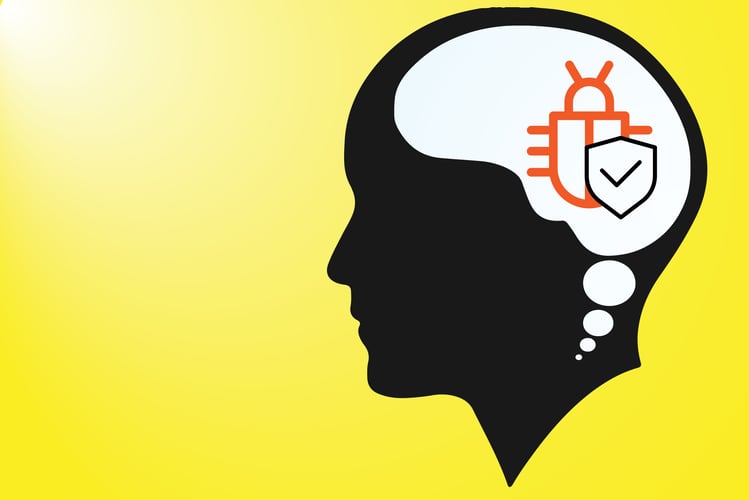Build Brain Cybersecurity!
- Home
- Blog

What You Will Learn in this Blog
- How chronic stress and other factors can “hack” your biological information systems, causing mental distress
- What hormesis is and how it can help you build a “cybersecurity” blueprint for better mental health
- Why acute stress is the best counter-agent to chronic stress
- How hormetic stressors like intermittent fasting and HIIT exercise can bolster the trillions of cells within your body.
“That which does not kill us, makes us stronger.”
— Friedrich Nietzsche
Reader, beware: your network’s being hacked! Malicious “software” is being secretly installed while you sleep, implanting itself within the very information systems you rely upon to function in your day-to-day life. “Files” that were once easily accessible are being rapidly encrypted by an enemy force, memory is being wiped out, and as long as you lack cybersecurity and remain unprotected, these actions may become irreversible. The results could be devastating. What can you do? Who can you call? Help!
At this point, you may be wondering, why is Dr. Kehr writing about IT cybersecurity in a psychiatry blog? The answer is simple. The very real threats to our external IT infrastructure that we read about almost every day are also taking place inside of each and every one of us—even at this very moment, as you read this blog—attacking and threatening the internal, biological IT infrastructure that governs how well we think, how good we feel, and ultimately, the very core of our being. Taking place at an atomic, molecular, and cellular level, this ongoing attack is often what’s responsible for chronic symptoms like brain fog, fatigue, depression, anxiety, OCD, and PTSD. To find out how, please read on.
Our Mental Health Ecosystem: A Biological Information Infrastructure
For all humans, every nanosecond of life depends upon the proper functioning of a vast information system inside our bodies - the extremely complex interconnections and moment-to-moment communications between 30 trillion human cells, 100 trillion microbial cells; and inside our brains - 100 billion neurons, 10,000 trillion synapses, and 100 billion glial cells. This vast, life-sustaining information system becomes even more complex inside our cells, each of which contains up to 2 trillion molecules and 70 trillion atoms, all interacting with one another based upon quantum biophysical laws!
According to Dr. David Sinclair and other prominent scientists, this vast molecular IT system is comprised of two basic types of information: DNA, a “digital information system” that provides the blueprint for building the structure and function of our cells, and our epigenome, an “analogue information system” that regulates how our genes express themselves to manufacture RNA and proteins.
Unfortunately, no information system is invulnerable to attack. So what are the different ways that this extremely elegant system can be “hacked?” What happens if the hacking is left unchecked? And what can we do to create our personal cyber-cellular-security program to restore, preserve, and protect our mental health information system?
Mental Health Malware, and the Ticking Time Bomb that Explodes into Mental Illness
Our own personal information ecosystem can be damaged in myriad ways that we have written about in earlier blogs, from damage to our DNA blueprint, to insufficient DNA methylation, macro and micro traumas to our cells, chronic inflammation, oxidative stress, toxins (both ingested and from toxic love and workplace relationships), poor diet, substance use and abuse, nutrient deficiencies, and obesity.
These biological forms of “malware” can quietly, surreptitiously corrupt your information system by damaging cells, disrupting genes, misfolding proteins, damaging the enzymes needed to speed up biological processes a billion times faster, and destroying those mitochondrial “power plants” that provide the energy that powers the entire system.
As we’ve covered in previous blogs, this type of damage can result in a higher risk of major depression, serious anxiety, worsening symptoms of PTSD and OCD, increasingly severe bipolar mood swings, psychosis, and dementia. The good news is that this malware can be “uninstalled,” and our memory system and its files can be “protected and recovered.” Sound too good to be true? Here’s how it’s possible.
Root Cause Psychiatry Harnesses Hormesis to Treat Chronic Stress with Acute Biological Stressors
In ancient times (hard to imagine in our time of abundance), nutrients were often incredibly scarce, the physical environment was unbelievably harsh, and our very survival was frequently threatened. If left unchecked, this hostile environment would damage the information system architecture inside our cells, including our DNA, RNA, proteins, enzymes, and mitochondria, threatening the continuity of life itself.
Miraculously, to enable life to survive on earth, repair systems emerged and evolved, and our DNA and epigenome developed some amazing mechanisms to turn off the growth of new cells (which depletes energy and nutrients) and repair environmentally-induced cellular damage to restore our information system integrity.
One of the primary repair mechanisms that evolved over time is called hormesis, a process whereby we can unlock and activate ancient systems inside our cells to preserve and protect life under conditions of extreme hardship. Hormesis in the body is triggered at times of acute stress (not chronic stress!) and has been shown to improve mitochondrial energy production by promoting increased efficiencies at the atomic and subatomic levels inside the mitochondria.
There are many “hormetic processes” that can make a big difference to our cellular health. For example, certain genes called SIRT1 – SIRT7 are activated at times of acute stress to repair our DNA, clear out damaged cellular molecules, and patch-up harm done to our mitochondria. The activation of these genes, and others like AMPK, and the deactivation of the mTOR genes, have all been shown to improve our cellular information systems, restore a “healthy cell identity,” and help prevent cellular senescence (“senile cells”) by reversing our biological clock to make our cells younger again.
Hormesis has been shown to improve not just our physical health, but also our mental health and well-being. If your biological information system has been “hacked”, hormesis can play a critical role in restoring systems back to their healthy state. So how can you “Hormetize” your cellular information system?
Become a Hormetic Hero to Build Better Mental Health
As we’ve discussed in prior blogs, chronic stress is one of the biggest “hackers” of our cellular information systems. A primary suspect in causing many mental (and physical!) health concerns, chronic stress promotes inflammation, excessive oxidative stress and free radical formation, damage to our microbiome and the important molecules that it manufactures, and leaky gut syndrome. Luckily, chronic stress doesn’t have to be forever. If chronic stress creates “metabolic malware” throughout our entire body, brain, and mind, hormesis can ride to the rescue if we faithfully practice it (and don’t overdo it!)
Ironically, one of the greatest ways to fight chronic (long-term) stress is to add intentional doses of acute (short-term) stress to your daily routine. Acute stressors such as calorie restriction, intermittent fasting, getting outside the “thermoregulatory zone” (by taking cold showers, cold plunges, steam, sauna, and jacuzzi baths), and high intensity interval training all promote hormesis—which in turn can help your body clear out “malware” and restore your systems to good health.
In addition, supplements such as NAD+ and Resveratrol also activate these cellular hormetic repair processes. And finally, scientific research may be on the verge of demonstrating that pharmaceuticals such as metformin and rapamycin may become more widely prescribed to activate these repair mechanisms and promote cellular health and longevity. With a little bit of commitment, you can use hormesis to build better mental health—and you can also use it to reclaim your cellular health, too.
Hormesis Builds Resilient Cells Throughout Your Body
Andrew Herr is a deeply respected colleague and friend of mine who led pioneering work on the links between physiology and performance to enable Navy SEALs to better survive under harsh combat-related conditions. As the founder of Fount, he is one of the foremost experts in the country on how best to promote and protect resilience at the cellular level and beyond, which, as we have written about in a prior blog, also builds better emotional resilience. Here is what Andrew has to say about hormesis:
“The right kind of stress is critical to optimal performance, whether you look at the individual cellular level or at the whole human system. Think of people sitting on a couch bored. If they don’t have some sort of stress or activation of their system, they won't be motivated to do anything. Many will find anxious thoughts filtering in, and they will all underperform their potential. But, with the right kind and amount of stress, they can get focused on a task and reach high levels of performance.
Similarly, if your body has no stressors, it will start to wither away and turn on itself. Just as unmotivated daydreaming can turn to anxious thoughts, when you have no physiological stress, your immune system starts to activate against any trivial stimulus, including often against yourself. This inflammation causes lower energy, worse mood, pain, and more—all symptoms that are so prevalent in society today. But if you stress your body with exercise, sauna, cold, and other approaches, your immune system saves its resources to protect you against bacteria, viruses, and other real threats, and you feel better.
This pattern is critical even within individual cells. For example, we have genes that turn on protective enzymes against free radicals and damage to our DNA and mitochondria, but cells require something they perceive as a stressor to turn these on! Without them, they get more damage than without any stress. This is the beauty of hormesis: with the right kind of stress in the right amounts, our cells, organs, bodies, brains, and even society all perform better and become more resilient. So, we all need to stress ourselves in a productive way. Work out, sauna, cold plunge, find goals you care about, and work towards achieving them. You can even get some of these benefits by eating foods that activate our hormetic response, especially dark colored fruits and vegetables with polyphenols that activate key genetic circuits!”
Building Brain Cybersecurity is Within Your Power
My dear reader, I am always wishing you much happiness, good health, and a more joyful life. While there are no substitutes for professional medical advice, if these blogs can contribute to improving your mental wellness, it is deeply satisfying to me. As we have discussed in today’s blog, hopefully I have provided you some tools to build your own cybersecurity blueprint, based in self-help actions that can prevent malware, destroy trojan horses, and defuse the ticking time bombs inside you. Through hormesis, you can restore the health of your information system architecture—the elegant communications between the trillions upon trillions of atoms, molecules and cells inside of you. Don’t let your body betray you, hold you hostage, and demand a ransom. Please don’t wait—begin to restore your biologic information system wellness today!
.png?width=144&height=144&name=Untitled%20design%20(34).png)



